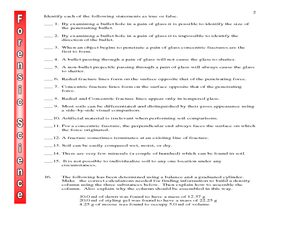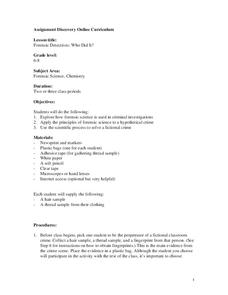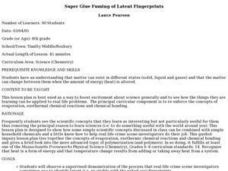Curated OER
Flesh Eating Bugs, Moldy Corpses, The Trail of a Killer
Learners read about how forensic entomologists use maggots to solve murders. In this forensic science lesson, students read an article and answer questions. They go to different websites about evidence and fingerprinting.
Curated OER
Cardiac Arrest! Using Forensics to Investigate Cardiovascular Anatomy and Function
Students identify the different parts and functions of the cardiovascular system. In this forensics lesson, students collect and analyze evidence on a fictional crime. They describe different causes of cardiac arrest.
Gene Jury
DNA Detectives
Police find a man murdered in a local hotel, DNA everywhere, and now they need scholars' help. Budding detectives step into a crime scene playing the roles of victim, suspects, and investigators. They apply knowledge of criminology and...
Curated OER
Physical Evidence
In this forensics instructional activity, students complete 14 short answer questions related to physical evidence. They explain how certain types of evidence are handled upon recovery from the crime scene.
Curated OER
Mission Possible
Students, in teams, solve a crime using forensic lab techniques. They apply lab techniques to a real life situation using a crime scenario that takes place on campus. Sample activities include Blood, Fiber, and Hair Lab.
Curated OER
Hair Test
In this forensic science activity, students answer 3 open response questions about hair evidence collected from the crime scene.
Curated OER
Forensic Detectives: Chemistry at Work
Students examine the different careers associated with chemistry and see how it is used everyday. In this forensic lesson students research a chemistry related career and write a presentation to give to the class.
Towson University
Case of the Crown Jewels
Can your biology class crack the Case of the Crown Jewels? Junior forensics experts try their hands at DNA restriction analysis in an exciting lab activity. The lesson introduces the concept of restriction analysis, teaches pipetting and...
Curated OER
Glass and Soil
In this forensic science lesson, learners sketch bullet line fractures and complete 16 short answer questions on glass and soil evidence.
Curated OER
Forensic Detectives: Who Did It?
Students explore forensic science and its uses in criminal investigations. They solve a fictional crime by identifying and analyzing the fingerprints, strand of hair, and thread samples for evidence. After completing charts for each,...
Howard Hughes Medical Institute
DNA Profiling Activity
Everyone loves a good mystery ... can your class actually solve one? Partnered pupils take on the role of forensic investigators during a three-part activity focusing on DNA evidence processing. Learners discover the methods used to...
Curated OER
DNA Fingerprinting
Students study the process of DNA Fingerprinting and how DNA Fingerprinting is used in solving crimes. They examine a crime scenario that involves collecting DNA Fingerprinting information from blood collected at the crime scene. They...
Curated OER
Who Did It?
Students apply the concepts from forensic science lessons to do a lab. They solve a mystery using experimentation and observation. They write a technically correct lab report.
Curated OER
Crime Scene Investigation (CSI) with Powdery Mildew Fungi
Students explore a specific method of identifying fungi, using a written key and an illustrated key. Powdery mildew fungi can be identified to genus by the morphology (appearance) of the sexual stage (cleistothecia).
Curated OER
Hair Test
For this forensic science worksheet, students write an open response to 3 short answer questions on hair evidence collected at the crime scene.
Curated OER
Hair Test
In this forensic science worksheet, students write an open response to 1 question about hair evidence collected from the crime scene.
Curated OER
Super Glue Fuming of Latent Fingerprints
Pupils explore latent fingerprinting. They observe a supervised demonstration of the process that real-life crime scene investigators sometimes use to identify latent fingerprints. In addition, they brainstorm ways to improve the process...
Curated OER
Hair Test
In this forensic science worksheet, learners write an open response to 3 questions posed about hair evidence in the crime scene. They explain where and why the samples are most likely found.
Curated OER
Interdisciplinary Applications of Chemistry Through Engineering in Modern Medicine
Students explore the different techniques used in forensic science. In this chemistry lesson plan, students investigate a fictional crime and identify the culprit. They create a brochure or collage career bulletin.
Curated OER
Hair
In this forensic science learning exercise, students identify the different parts of the hair. They complete 18 short answer questions on how hair evidence is used in forensics.
Curated OER
Who Is It?/Who Done It?
Students conduct an experiment that allows them to assess individual differences in random DNA sequences and apply those differences when solving a forensic problem. After discussing the polymerase chain reaction and its use to identify...
Curated OER
Using Blood Tests to Identify Babies and Criminals
Students solve a crime by matching a suspect's blood type to physical evidence collected at the crime scene. For this forensic science lesson, students identify the different blood types. They explain how blood tests work.
Curated OER
Hair Test
In this forensic science worksheet, students write an open response to 2 questions about a picture of hair evidence collected from the crime scene.
Curated OER
Hair Test
In this forensic science worksheet, high schoolers write an open response to 1 question on hair evidence photo taken from the crime scene.

























